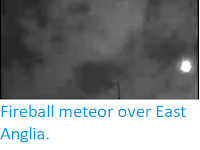The Southern Taurid Meteor Shower will peak on Thursday 10 October 2019,
the first of two overlapping meteor showers associated with the constellation of Taurus, the second being the Northern
Taurids which will peak on Tuesday 12 November. The showers take their
name from the constellation of Taurus, where their radiant point (the
point from which they appear to radiate) can be found. Visibility may be somewhat hampered this year, as the meteor shower
peaks slightly before the Full Moon on Sunday 13 October, so that the
meteors may be obscured by the brightness of the Moon.
The radiant points (points from which the meteors appear to radiate) of the Southern and Northern Meteor Showers. EarthSky.
The Southern Taurid Meteor Shower is caused by the Earth passing through the trail of
Comet 2P/Encke, this is particularly spread out, so that the Earth takes
several weeks to pass through it. This is thought to be because Encke
is a remnant of a much larger Comet, which has broken up over the past
20 000 to 30 000 years, giving a long, spread-out debris stream.
Comet 2P/Encke imaged on 20 February 2017. The comet appears to have three tails; one of these is the ion tail, a stream of charged particles that points directly away from the Sun, the other is dust tail made by fragments of dust shed by the comet in its path, which go on to form meteor showers. On this occasion the ion tail has been split in two by turbulence in the Solar Winds, creating the impression of a third tail. Fritz Helmut Hemmerich/Flikr/Astronomy Picture Of the Day/NASA.
Comet 2P/Encke was first observed by French astronomer Pierre Méchain in
1786, but gets its name from the German astronomer Johann Franz Encke,
who calculated its orbit in 1818. The designation 2/ implies that it was
the second Periodic Comet (comet with an orbital period of less than 200 years) ever discovered.
The calculated orbit and current position of 2P/Encke . JPL Small Body Database.
Comet 2P/Encke completes one orbit every 1204 days (3.3 years) on an eccentric orbit tilted at 11.8° to the plane of the Solar System, that takes it from 0.34 AU from the Sun (34% of the average distance at which the Earth orbits the Sun, and inside the orbit of the planet Mercury) to 4.09 AU from the Sun (4.09 times as far from the Sun as the Earth,considerably more than twice the distance at which the planet Mars orbits the Sun).
See also...
Follow Sciency Thoughts on Facebook.









